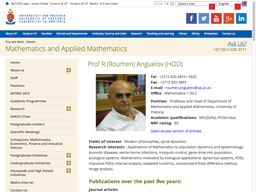GT Pequan

Pattern formation in a coupled Brusselator model
 Jueves 24 de septiembre de 2015
Jueves 24 de septiembre de 2015Roumen Anguelov (University of Pretoria)
The Brusselator model is widely used to illustrate and study basic features of models of chemical reactions involving trimolecular steps. A single layer model is a system of reaction diffusion equations of the form
∂u/∂t = a − (b + 1)u + u²v + D_u ∆u (1) ∂v/∂t = bu − u2 v + D_v ∆v (2)
The numerical investigation presented in the talk provides an insight into the asymptotic behavior of the solutions of this model, characterizing the parameter region for each of the three qualitatively different cases: homogeneous steady state, Turing pattern and bulk oscillations. Particular attention is given to the supercritical Hopf bifurcation parameter domain where no substantial theory is available. This study was largely motivated by the observations in [1] that Turing patterns eventually (for sufficiently small ratio of the diffusion coefficients) dominate the Hopf bifurcation induced bulk oscillations. In our work we confirm this observation and further establish more precisely the shape of the boundary separating the Turing pattern domain and the bulk oscillations domain in the parameter space. The obtained results are used in revealing an essential mechanism generating oscillating patterns in the coupled Brusselator model. This model consists of two systems of the form (1)-(2) coupled via linear terms. It can be considered as a model of the reaction sequences in two thin layers of gel that meet at an interface. Each layer contains the same reactants with the same kinetics but with different diffusion coefficients. The occurrence of oscillating patterns is due to the fact that for the same values of the parameters a and b but with different diffusion coefficients the one system can be in the Turing pattern domain while the other into the bulk oscillations domain. Hence, roughly speaking, one layer provides a pattern while the other layer drives the oscillations.
[1] L. Yang, A.M. Zhabotinsky, I.R. Epstein, Stable squares and other oscillatory Turing patterns in a reaction-diffusion model, Phys. Rev. Lett. 92 (2004) 198303.
Más detalles aquí …
marc (at) nullmezzarobba.net